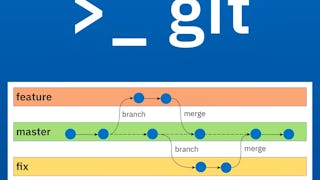In this course, you’ll learn how to keep track of the different versions of your code and configuration files using a popular version control system (VCS) called Git. We'll also go through how to set up an account with a service called GitHub so that you can create your very own remote repositories to store your code and configuration.

Enjoy unlimited growth with a year of Coursera Plus for $199 (regularly $399). Save now.

Introduction to Git and GitHub
This course is part of Google IT Automation with Python Professional Certificate

Instructor: Google Career Certificates
337,752 already enrolled
Included with
(7,937 reviews)
What you'll learn
Understand why version control is a fundamental tool for coding and collaboration
Install and run Git on your local machine
Use and interact with GitHub
Collaborate with others through remote repositories
Skills you'll gain
Details to know

Add to your LinkedIn profile
16 assignments
See how employees at top companies are mastering in-demand skills

Build your Cloud Computing expertise
- Learn new concepts from industry experts
- Gain a foundational understanding of a subject or tool
- Develop job-relevant skills with hands-on projects
- Earn a shareable career certificate from Google

There are 4 modules in this course
In this module, you'll be introduced to the concept of version control, which will make managing and rolling back your code look super easy. You’ll learn how to differentiate between files and the tools at your disposal to make this happen. Next, you'll be introduced to Git and how you can leverage that platform to improve your coding abilities. Once you’ve got a grasp on what Git is, you’ll install it and start using it to create and clone code repositories. Last up, you’ll deep dive into Git in order to get more familiar with the different tools and commands it has to offer.
What's included
16 videos15 readings4 assignments1 app item
In this module, you’ll dive into advanced Git interactions by skipping the staging area for small code changes, and understand how Git uses the HEAD alias to represent checked-out snapshots. Next, you’ll explore how to move and remove files before finally getting a study guide to help you in your Git explorations! The next step of your learning will include how to undo changes before committing and how to amend commits once they’re submitted. Finally, you’ll be able to identify errors in commits that were submitted a while back. In the final section of this module, you’ll explore the concept of branching and merging. You’ll learn what a branch is, how to create one, and how they work in harmony with you and your code. Once you’re comfortable with branching, you’ll dive into merging, how it works with branched data, and how to deal with merge conflicts.
What's included
14 videos16 readings4 assignments1 app item
In this module, you’ll be introduced to GitHub and learn how it works with Git. You’ll create new repositories and clone those repositories onto your computer. Next, we’ll explain what a remote repository is, how we can work with them, and how we can host them. You’ll get familiar with commands like modify, stage, and commit, which will be used for local changes, as well as the fetch command, which can pull any changes from remote repositories. We'll cover secure shell protocol and when to use API keys. Our final lesson will focus on learning about conflicts. This will allow you to explore the concepts of pull-merge-push workflows, pushing remote branches and rebasing your changes.
What's included
13 videos19 readings4 assignments1 app item
In this module, you’ll continue to explore the collaboration tools available in Git. You’ll learn about the tools that are available to help improve the quality of your code and to better track your code. This includes an overview of pull requests and how the typical workflow of a pull request looks like on GitHub. Next, you’ll dive into how you can squash changes in your code. We’ll finish up by providing you with a study guide on fork and pull requests. Next up, we’ll cover what code reviews are and what the code review workflow looks like. Then, you’ll learn about how to use code reviews on GitHub. The final lesson of this module will focus on managing projects. We’ll take a rundown of best practices on managing projects and how to manage collaboration within those projects. We’ll explore different ways of tracking issues and finish up by discussing the concept of continuous integration with your projects.
What's included
14 videos15 readings4 assignments1 app item
Earn a career certificate
Add this credential to your LinkedIn profile, resume, or CV. Share it on social media and in your performance review.
Instructor

Offered by
Explore more from Cloud Computing
 Status: Free Trial
Status: Free Trial Status: Free Trial
Status: Free Trial
Packt
 Status: Free Trial
Status: Free Trial
Why people choose Coursera for their career




Learner reviews
7,937 reviews
- 5 stars
82.18%
- 4 stars
15.07%
- 3 stars
1.81%
- 2 stars
0.42%
- 1 star
0.49%
Showing 3 of 7937
Reviewed on Feb 5, 2020
Even though it's an introductory course and everyone must get deeper into those topics, this course is very complete and provides you all the necessary to work with git in a real IT enviroment.
Reviewed on Jul 18, 2020
This course is full of priceless information, but at the same time to the point. I reckon I will come back to the videos as I encounter new challenges particularly when collaborating with a team.
Reviewed on Jun 17, 2020
This course was really helpful for me. I was having experience with git and github but surprisingly I get to know many new things from this course and instructor is simply awesome and excited!

Open new doors with Coursera Plus
Unlimited access to 10,000+ world-class courses, hands-on projects, and job-ready certificate programs - all included in your subscription
Advance your career with an online degree
Earn a degree from world-class universities - 100% online
Join over 3,400 global companies that choose Coursera for Business
Upskill your employees to excel in the digital economy
Frequently asked questions
To access the course materials, assignments and to earn a Certificate, you will need to purchase the Certificate experience when you enroll in a course. You can try a Free Trial instead, or apply for Financial Aid. The course may offer 'Full Course, No Certificate' instead. This option lets you see all course materials, submit required assessments, and get a final grade. This also means that you will not be able to purchase a Certificate experience.
When you enroll in the course, you get access to all of the courses in the Certificate, and you earn a certificate when you complete the work. Your electronic Certificate will be added to your Accomplishments page - from there, you can print your Certificate or add it to your LinkedIn profile.
More questions
Financial aid available,

